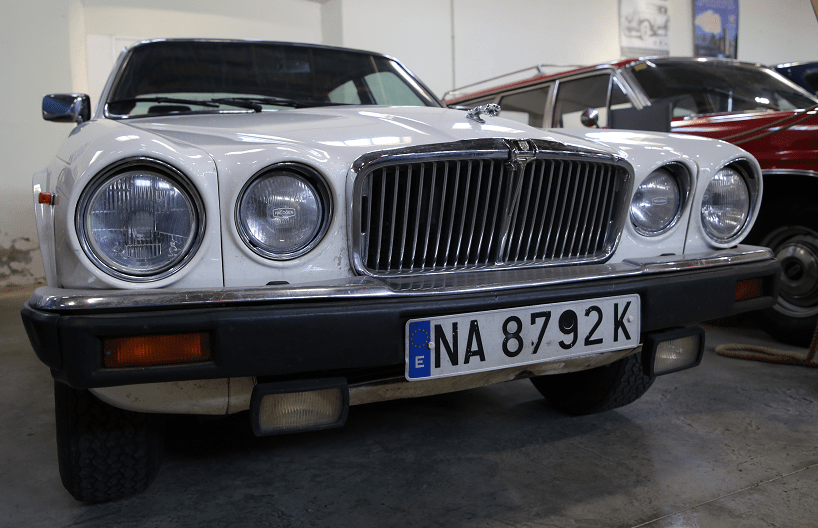White Jaguar XJ6 4.2 from 1981, six cylinders, 4200 cc, 245 HP
The Jaguar XJ is a series of full-size luxury cars produced by British automobile manufacturer Jaguar Cars (becoming Jaguar Land Rover in 2013) from 1968 to 2019. It was produced across five basic platform generations (debuting in 1968, 1986, 1994, 2003, and 2009) with various updated derivatives of each. From 1970, it was Jaguar’s flagship four-door model. The original model was the last Jaguar saloon to have had the input of Sir William Lyons, the company’s founder, and the model has been featured in countless media and high-profile appearances.
Series 3 (1979–1992)
The car was significantly facelifted again in April 1979, known as the Series III, incorporating a subtle exterior redesign by Pininfarina. Changes from the Series II included thicker and more incorporated rubber bumpers with decorative chrome only on the top edge, flush door handles, one-piece front door glass without a separate quarter light, a grille with only vertical vanes, reverse lights moved from the boot plinth to the larger rear light clusters, and a revised roofline with narrower door frames and increased glass area. The option of a sunroof and cruise control were also offered for the first time. Also For the series 3 Jaguar asked Pirelli to develop a new tyre the Cinturato P5 to improve the handling and performance of these luxury cars in 205/70R15 Cinturato P5 for the 6 cylinder cars and 215/70R15 Cinturato P5 for the V12.
The 5.3 L V12, 4.2 L and 3.4 L straight-six engines carried over from the Series II, with minor changes. The larger six-cylinder and V12 models incorporated Bosch fuel injection (made under licence by Lucas) while the smaller six-cylinder remained carburetted. The smaller six-cylinder engine was never offered in the US, and the V12 was no longer offered there after 1980.
The 1979 UK model range included the Jaguar XJ6 3.4 and 4.2, XJ12 5.3, Daimler Sovereign 4.2 and Double-Six 5.3, and Daimler Vanden Plas 4.2 and Double-Six Vanden Plas 5.3. In 1981, the cylinder heads of the V12 engine were replaced by the new Fireball high-compression design by Swiss racing driver Michael May, and were badged from this time onwards to 1985 as “HE” (High Efficiency) models.
In late 1981, the Daimler Sovereign and Double Six models received a minor interior upgrade for the 1982 model year with features similar to Vanden Plas models. Also for the 1982 model year, a top spec Jaguar Vanden Plas model was introduced in the US market. In late 1982, the interior of all Series III models underwent a minor update for the 1983 model year. A trip computer appeared for the first time and was fitted as standard on V12 models. A new and much sought-after alloy wheel featuring numerous distinctive circular holes was also introduced, commonly known as the “pepperpot” wheel. Pirelli tyres were also fitted as standard equipment.
For the 1984 model year, the Sovereign name was transferred from the Daimler marque to a new top-specification Jaguar model, the Jaguar Sovereign. A base Jaguar XJ12 was no longer available, with the V12 engine only being offered as a Jaguar Sovereign HE or Daimler Double Six. The Vanden Plas name was also dropped at the time in the UK market, due to Jaguar being split from British Leyland and privatised; the name was used on top-of-the-range Rover-branded cars. Daimler models became the Daimler 4.2 and Double Six and were the most luxurious XJ Series III models, being fully optioned with Vanden Plas spec interiors. The Vanden Plas trademark was retained by Jaguar in North America, and top-of-the-line XJs were still sold there with the Vanden Plas name. The 1984 UK model range included the Jaguar XJ6 3.4 and 4.2, Sovereign 4.2 and 5.3, and Daimler 4.2 and Double Six 5.3.
Production of the six-cylinder Series III XJs continued until early 1987, after which it was replaced by the all-new XJ40, while production of 12-cylinder Series III XJs continued until 1992. The last 100 cars built were numbered and sold in Canada as part of a special series commemorating the end of production. These 100 cars featured the option of having a brass plaque located in the cabin. It was the original purchaser’s option to have this plaque, which also gave a number to the car, such as No. 5 of 100, fitted to the glove box, to the console woodwork or not fitted at all. This brass plaque initiative did not come from Jaguar in Coventry: it was a local effort by Jaguar Canada staff and the brass plaques were engraved locally.
132,952 Series III cars were built, 10,500 with the V12 engine. In total between 1968 and 1992 approximately 318,000 XJ6 and XJ12 cars were produced.












